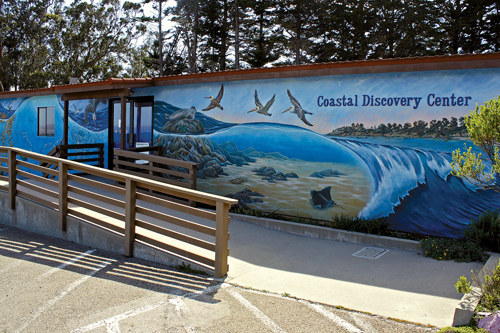
There is a little gem of a natural history museum located at the William Randolph Hearst Memorial Beach right across from the entrance road to Hearst Castle. Drivers can’t miss it as they pull into the beach parking lot: a bright and colorfully painted mural decorates the front of the building.
The Discovery Center is a collaboration between the Monterey Bay National Marine Sanctuary and California State Parks. Carolyn Skinder, the Southern Regional Program Coordinator of NOAA Monterey Bay National Marine Sanctuary and Director of the Coastal Discovery Center, is in charge here along with many State Park docents, volunteers and interns.
Visitors to the Center will learn about the natural and cultural resources of the area through interactive exhibits and special programs. One of the exhibits explains how watersheds work, and shows how water flows from land to sea and how important it is to keep the water clean. It is exemplified best by a large aquarium filled with active rainbow trout. These trout are the same species that are found in local fresh water streams. Kids that are present at the end of the day get to feed the fish, as do school kids that come for the special programs offered on Wednesdays and Fridays.
Near the aquarium is an exhibit explaining about the deep-sea exploratory voyages that take place in the waters of the Monterey Bay National Marine Sanctuary using special underwater craft. This sanctuary extends 275 miles from the Gulf of the Farollones Sanctuary near San Francisco to Cambria and is the largest and deepest of the nation’s marine sanctuaries. This exhibit describes the deep sea habitats and the hundreds of shipwrecks located there. Three short videos show the explorations made to the Davidson Seamount, the sunken oil tanker, Montebello, and dirigible, USS Macon.
A fascinating interactive exhibit has to do with phytoplankton. Skinder said, “Visitors can take the capture equipment out to the pier and lower it into the ocean and take a water sample. Then they return to the Center and place a droplet of water onto a slide and slip that under the microscope and what they have captured is shown on the monitor.” She placed a sample under the microscope and the screen filled with hundreds of tiny cellular creatures, diatoms and copepods. Some sat still, but others dashed about in the water sample. “This really brings home to the visitor what is living in the sea, even though you cannot see them with the naked eye, and helps to emphasize the importance of keeping our oceans clean,” Skinder commented.
Kids have lots of fun at the Discovery Center. They can participate in a Junior Ranger program using an activity book that utilizes all the exhibits at the Center for guidance. Upon completion they receive a certificate awarding them Junior Ranger status.
Thanks to the California Coastal National Monument, another conservation organization, the Discovery Center was gifted with fanny packs containing a pair of binoculars, and two guides to marine, tidepool life, birds and mammals of the area. Visitors can take the packs on loan and spend the day searching out the creatures in the guides. The tide pool and wildlife viewing exhibits in the Center also focus on identification. Another display explains about the local elephant seal phenomenon that has been occurring just north of the Center at Piedras Blancas.
Cultural history is an important part of the story told by the Center. San Simeon Cove has been in use by humans from early Native American times through the whaling industry period, followed by the Hearst era. On the first weekend of every month docents gather people out on San Simeon pier from 11 A.M. to 1 P.M. and tell about these periods of time. Inside the Center there is an interactive touch screen exhibit that also explains all this fascinating history.
Thirty volunteers donate time at the Center and they have gone through a training program that includes not just the items at the Center but every facet of the local marine and land environment. These volunteers get to talk to 80,000 visitors a year and 3,000 students. Others are volunteer monitors who collect water samples, do weekly plankton monitoring for the Department of Health, monitor the rocky tide pools, and do monthly counts of beach cast marine mammals and seabirds at various sites within the Sanctuary. Along with the exhibits in the Center there are interpretive signs all along the San Simeon pier addressing cultural history, marine life, bird life, and more.
Admission to the Discovery Center is free and the center is handicap accessible. It is open Friday through Sunday from 11:00 am to 5:00 pm. For more information, visit montereybay.noaa.gov/vc/cdc or call (805) 927-6575.
July 21, 2012: Coastal Discovery Fair
This annual family event features more than 20 environmental agencies. Pacific Wildlife Care brings their live animals, and Air Strike Control brings raptors. Visitors will be able to create and control their own small remote-controlled underwater robot, and kids can shake fins with Sammy the Steelhead and play the Steelhead game. Admission is free.
— Ruth Ann Angus










